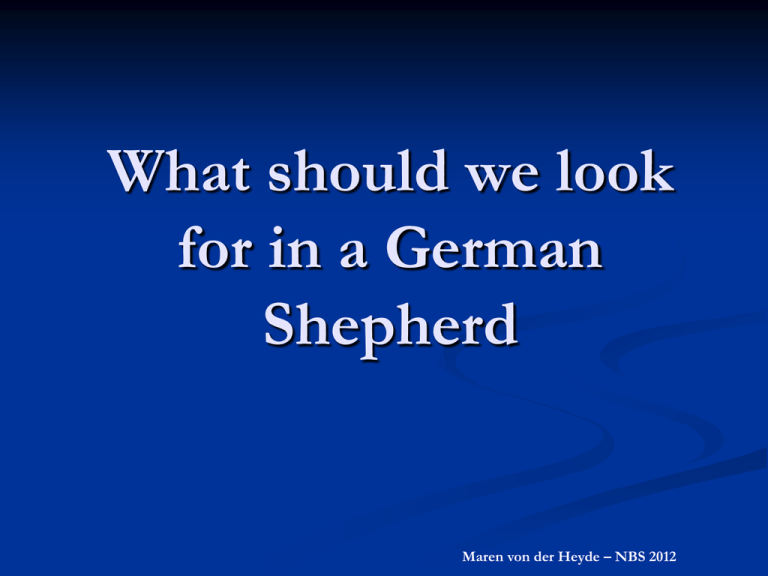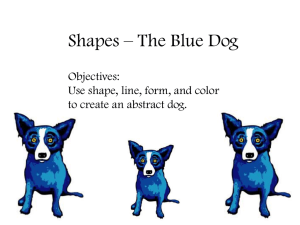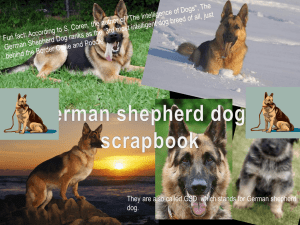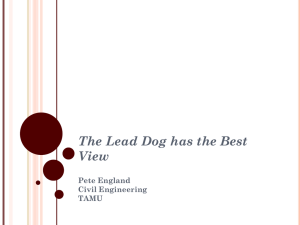
What should we look
for in a German
Shepherd
Maren von der Heyde – NBS 2012
The German Shepherd Dog has become a concept
worldwide for dependability , faithfulness , and
many versatile uses . Also the dog can be used as
a service dog , protection dog , herding dog ,
tracking dog , guide dog for the blind , and
rescue dog , to mention only some of the
possibilities . The extent of the uses has become
so great that all of them cannot be mentioned .
It is a credit to the goodwill of the dog and the
skill of the breeder that the field of use of the
German Shepherd Dog is so large .
The German Shepherd Dog is a
WORKING DOG
These eight words form the basis for working with
the dog , judging the dog , and thinking about
breeding, in short , for all the effort we put in
the dog .
So you can see how useful it is in judging the
structure to keep in mind the achievement and
uses of the dog .
To be a working dog means that the dog must be so
structured and bred that with minimum expenditure of
energy the dog can produce the greatest level of
performance .
Therefore , the structure must be in harmony , with no
exaggeration or understatement in the angulation , size ,
weight , or chest structure .
For this reason , the German Shepherd can only be
judged , and the characteristics of the breed demand
that it be judged , as a working dog .
Functionality is above beauty and fashion .
His real beauty and nobility are in complete functionality ,
in the harmonious relationship of all parts .
The judge should be cautious in leaving out
specific faults or virtues but should weigh them
if flaws are of extreme importance for the workuse of the dog .
In viewing your dog it should be immediately
evident as to the sex of your dog . A male
should look like a male and a female like a
female .
At the first general overview , the judge should
consider at first the general condition , sexual
characteristics , character , strength , expression ,
symmetry , nobility , constitution and condition .
Size
The German Shepherd belongs to the medium sized
breeds , which means that it is approximately 60 cm
high at the withers , the males measuring 60-65 cm and
the females 55-60 cm .
The ideal measurements are : 63 cm for males and 58 cm
for females .
The withers are the only point where height is measured
in a dog . The animal is measured standing evenly on all
fours , and is measured at the highest point of the
withers , with the hair pushed down , vertically
downwards , touching the elbow , to the ground .
Giants are not agile
Performance and use require specific degree of size and
strength .
If the dog is oversized , he is either too heavy because
increased size means increased weight over proportional ,
or he is long legged , which means he has a poor chest
structure and steep ankles .
Too large and too heavy dogs have too much weight . It is
too difficult for them to stop , jump and climb .Besides ,
they are mostly unwilling to work and tire easily .
Long legged dogs are even more restricted in performance.
The poor angulation causes them to not be fluid in motion
.In addition to this comes insufficient chest structure ,
insufficient room for organs , and fine bones .
Small dogs
With too small dogs , even with harmonious structure ,
strength is missing . They are fine-boned , they are fast
and flexible , but they have little endurance .
Or , they have the right amount of strength , but the leg
bones are too short . The chest is then too deep , and
they have little reach and a rolling gait .
The requirements for use – strength ,
endurance , flexibility and speed – can only
be achieved by medium sized dogs .
The German Shepherd Dog is a
mover !
Therefore he has a sufficiently stretched posture .
The relationship of height to length is 9 to 10 .
If the dog is shorter he tires faster in trotting and
tends to gallop .
Long legged animals can only partially use rear
quarter strength , and tend to have weak backs .
The weight
Medium heavy males weigh : 37- 40 kg
Medium heavy females weigh : 29 – 32 kg
Distribution of weight :
Muscles
53%
Bones
14%
Coat
12%
Blood
8%
Organs , fat etc.. 13%
The strength of the dog lies primarily in muscles and
bones . The bone structure should be firm and dry .
13%
muscles
8%
bones
53%
12%
coat
blood
organs , fat etc…
14%
The coat
The German Shepherd has a pronounced outer
coat with a dense , firm inner coat .
Too short a coat exposes the dog to the elements .
Too long hair with no undercoat allows the dog to
become wet too fast , and exposes him to
matting ( which can be torn when going through
underbrush ) . Dogs with long hair and no
undercoat cannot be bred .
The pigment
In the entire breeding science of service animals ,
the fading of colors is tied in with the lack of
inner structure and lack of resistance against
illness .Signs of fading are light insides of legs ,
light toenails and red tail tips .
The lines of the dog
The lines shall be in harmony .
The top line begins at the ear tips , and continues
without a sharp bend or break , gently falling to
the tail tip .
The underline begins at the neck and leads across
the front and lower chest with a slight tuck up
towards the back .
The tail
The tail is carried saber like , hanging downward . Even in
excitement it shall not be raised above the line of the back .
The tail can be anywhere from 18 – 23 vertebrae long , but
it should not touch the ground when standing . Flaws in the
holding of the tail are especially noticeable when the dog is
moving .
The genitals
The genitals in bitches do not require any special judging .
In males , judging is to notice if they are strongly
developed .
The testicles must be visible , strongly developed , and
well placed . The missing one or both testicles or if one
is insufficiently developed , designates that there is to
be no breeding of the male .
Such a flaw is a sign that the body does not produce
enough hormones . This is an inherited trait .
Teeth
Puppies have 28 first or “milk teeth” . The molars and premolars
are missing .
The second set , or adult set , consists of 42 teeth .
Upper jaw – 20 ; lower jaw – 22 :
6 incisors , upper and lower
12
2 canines , upper and lower
4
8 premolars , upper and lower
16
4 upper molars
4
6 lower molars
6
total
42
The crushing teeth are the no 4 premolars ( upper ) and the no 1
molars ( lower ) . Between those a pressure of 1.65 kg per square
cm can be produced .









